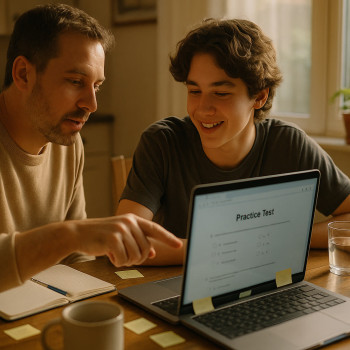Why a Shared Family Calendar Is Your Secret Weapon for SAT Success
The college application season is one of those life phases that can feel equal parts exciting and chaotic. Between schoolwork, extracurriculars, application forms, and—yes—the Digital SAT, it’s easy for deadlines to slip through the cracks. That’s where a shared family calendar comes in: it’s not just a tool for knowing who’s picking up whom at what time. Used well, a shared calendar becomes a planner, an accountability partner, and a stress reducer all in one.

What a good shared calendar does for SAT planning
- Makes deadlines visible to everyone who needs to know (students, parents, counselors).
- Helps balance prep sessions with schoolwork and personal time.
- Creates natural reminders so applications, score-sends, and registration dates aren’t last-minute scrambles.
- Encourages collaborative problem-solving—when conflicts appear, the family solves them together.
Start with a Simple Plan: The Calendar Pipeline
Before you add one single event, agree on a small set of rules. Call these your Calendar Pipeline: how you enter events, who confirms them, and how reminders are handled. A few minutes discussing this upfront saves hours later.
Calendar Pipeline checklist
- Choose a single shared calendar platform that everyone will actually use.
- Designate color-coding for types of events: test dates, registration deadlines, study blocks, and family commitments.
- Decide who can edit and who can only view. Often parents and the student should both be editors; a college counselor can be a viewer.
- Set default reminders—two automatic notifications for every deadline (e.g., two weeks and three days before).
- Hold a quick weekly check-in where the student and parent scan the week’s events together.
What to Put on the Calendar: A Practical Checklist
Not everything needs to live on the calendar. But when it comes to SATs and college applications, there are essential items you should never miss.
Core SAT-related events to add
- Official SAT test dates and registration deadlines.
- Late registration windows and change deadlines.
- Score release dates (so you know when to send scores to colleges if needed).
- Bluebook or test-day device setup appointments (important for the Digital SAT).
- Practice test dates and result review sessions.
- Application milestones tied to SAT scores—e.g., last acceptable test date for early action or scholarship consideration.
Smart extras to include
- Blocks for focused study sessions (Pomodoro style or longer deep-focus windows).
- Mock-test mornings with a quiet house commitment from family members.
- Deadlines for recommendation letters, transcript requests, and counselor forms that can be influenced by SAT timing.
- Family checkpoints: small celebrations after each practice test or score improvement.
Example Timeline: How One Junior Uses a Shared Calendar
To make this concrete, here’s an example timeline. Imagine a junior in October planning for the Digital SAT in December and March of the following year. The family calendar helps align practice, registration, and other deadlines.
| Item | Typical Timing | What to Put on the Calendar |
|---|---|---|
| Choose test date | 3–4 months before application deadlines | Event: “Decide target test date” with 1-week decision window; reminder for registration date |
| Register for SAT | Registration deadline (varies by date) | Event with registration deadline and a “confirm registration” subtask |
| Practice test | Every 4–6 weeks | Mock test events with family quiet hours flagged |
| Score release | ~2–4 weeks after test date | Score release event; action items for sending scores if needed |
| Final test (last acceptable for deadlines) | 2–4 weeks before application deadline | High-priority calendar event and test-day logistics checklist |
Choosing the Right Tool: Calendar Apps and Why They Matter
There are lots of shared calendar apps—some families use Google Calendar, some use Apple Calendar, and others prefer platforms that integrate with task managers. The best choice is the one your family will consistently use. Here are the features to prioritize.
Must-have features for SAT planning
- Easy sharing and permission controls so everyone can view and relevant people can edit.
- Color-coded calendars that let you see “SAT prep” vs. “school” vs. “family” at a glance.
- Robust reminders with customizable lead times (email, push, and SMS are ideal).
- Ability to attach files or links—useful for adding registration confirmations, admission tickets, or Bluebook setup notes.
- Mobile and desktop sync so events show up everywhere.
Putting It into Practice: Weekly Routines That Work
A shared calendar is only as good as the routine that supports it. Try a weekly rhythm to make sure your SAT plan stays alive.
Sunday check-in (15–20 minutes)
- Student and a parent review the week: what tests, practice sessions, commitments are scheduled.
- Confirm study blocks and quiet-house times around full-length practice tests.
- Reassign or reschedule anything that conflicts with family obligations.
Monthly alignment (30 minutes)
- Review upcoming registration and score release dates; double-check application deadlines tied to SAT dates.
- Update the calendar with any new priorities (e.g., an extra practice session or a tutoring milestone).
- Celebrate wins—small rewards for practice improvements keep momentum going.
Handling Common Pitfalls (and How a Shared Calendar Fixes Them)
Even the best systems run into hiccups. Here are common issues families face and how shared calendars help fix them.
Pitfall: “I thought you registered already.”
Fix: Put registration as a calendar event with a checkbox subtask: “Register” and “Confirm email receipt.” That makes the task visible and accountable.
Pitfall: Test date conflicts with an important family or school event.
Fix: Use the calendar’s color-coding to spot conflicts early and create contingency plans—either change the test date (if registration allows) or move the conflicting event.
Pitfall: Missing the late registration deadline or scoring window.
Fix: Add both the regular deadline and the late registration deadline as separate events with different reminder lead times and include the extra fee note for late registration.
Making the Digital SAT Specifics Work for You
The Digital SAT introduces device considerations and online setup steps that aren’t as relevant for paper testing. These technical deadlines deserve space on your family calendar.
Digital SAT items to schedule
- Time to set up and test the student’s device if required (Bluebook or other exam app) — schedule this at least a week before test day.
- A quiet practice session using the same digital format so the student is comfortable with navigation and timing.
- Reminders to download any required software and confirm login credentials.
- Events to check College Board notifications for device loan deadlines or special instructions.

Using Reminders, Tasks, and Attachments Effectively
Reminders are the backbone of a reliable calendar. But attachments and small task lists turn calendar events into action-ready items.
Best practices
- Attach the registration confirmation and admission ticket to the calendar event so they’re easy to find on test day.
- Add a pre-test checklist as an event note: ID, admission ticket, charged device, water bottle, quiet space.
- Use checklist subtasks for multi-step items like “Send scores to colleges” where you include the college names and deadlines.
How Tutoring Fits Into Your Calendar: Make Prep Predictable
One of the most powerful ways to improve SAT scores is regular, targeted practice with feedback. That’s why scheduling tutoring sessions directly on the shared calendar is so effective. It removes the friction of trying to coordinate times and keeps prep consistent.
A note about Sparkl’s personalized tutoring
For families exploring tutoring options, Sparkl’s personalized tutoring can be slotted right into this calendar system. Sparkl offers 1-on-1 guidance, tailored study plans, expert tutors, and AI-driven insights that help identify the exact skills a student should focus on. Treat scheduled Sparkl sessions like test appointments—put them on the calendar with study goals for each session and brief post-session reflections to track progress.
Example Calendar Setup: A Month-by-Month Plan
Below is an illustrative four-month setup that balances practice, tutoring, and administrative deadlines. Adjust the timeline depending on your student’s target test date.
| Month | Focus | Calendar Actions |
|---|---|---|
| Month 1 | Baseline & Registration |
|
| Month 2 | Skill-building |
|
| Month 3 | Timed practice & strategy |
|
| Month 4 | Final tuning & logistics |
|
Communicating Calmly: Tone Matters in Calendar Conversations
Calendars are technical tools, but family buy-in is emotional. Use a supportive, non-judgmental tone when discussing missed events or low practice scores. The calendar should encourage action, not guilt. Treat each calendar entry as an invitation to collaborate rather than a demand for perfection.
Scripts that help
- “Let’s move the practice test so you have family quiet time—what day is better?”
- “I see registration is open for the October date. Want me to set a reminder to register on Monday?”
- “Great job on this practice—shall we schedule a short review with your tutor this week to lock in what you learned?”
Privacy and Boundaries: Who Sees What?
Shared calendars are powerful, but they can also feel invasive if not managed thoughtfully. Protect student privacy and encourage independence by setting boundaries around what’s visible and editable.
Practical boundary guidelines
- Allow the student to keep score details private if they prefer—calendar entries can note “score review” without listing the exact score.
- Keep permission levels flexible: parents can be editors for logistics, while tutors or counselors are viewers.
- Use event privacy settings for sensitive reminders (e.g., a counseling appointment).
When to Escalate: Problems That Need Extra Help
Most scheduling wrinkles are solved at the family level. But sometimes you’ll spot patterns—persistent missed practice, technical issues with digital testing, or rapidly approaching deadlines without readiness. That’s the time to bring in specialized support.
Signs you might need extra support
- Repeated missed practice tests despite reminders.
- Technical uncertainty about the Digital SAT setup that could jeopardize test day.
- Need for faster improvement before a critical application deadline.
In these cases, scheduling a focused series of tutoring sessions (for example, with a provider offering 1-on-1 tailored plans and expert tutors) can create an intensive lift and help meet short-term goals. Add these session blocks as calendar events with clear objectives: what you’ll cover and what success looks like.
Final Checklist: Calendar Setup in 20 Minutes
Here’s a quick checklist to create a robust shared calendar system for SAT planning in under half an hour.
- Create and share one family calendar; name it clearly (e.g., “Alex SAT + College”).
- Enter official SAT test dates and registration deadlines for the next 12 months.
- Schedule weekly study blocks and monthly full-length practice tests.
- Add device setup and test-day checklist events for Digital SAT specifics.
- Attach registration confirmations and add reminder alerts two weeks and three days before every deadline.
- Block out quiet-house windows for practice test mornings and mark them as high priority.
- Schedule weekly 10–15 minute check-ins between student and parent to review the calendar.
A Little Encouragement to Close
Using a shared family calendar to manage SAT deadlines isn’t about micromanaging a student’s life. It’s about creating a reliable, kind structure that protects time for focused practice, reduces last-minute stress, and makes the college application journey feel less like a sprint and more like a well-paced climb. When everybody knows what’s coming—and what to do about it—students can prepare with confidence and families can support without constant reminders.
Take one small step today: add the next official test date and its registration deadline to your shared calendar. Then schedule a short practice test and a single, simple tutoring session. Momentum follows action, and with the right plan—plus dependable tools and occasional expert help—your student will be ready when it counts.
If you’d like help turning your calendar into a tailored study roadmap, consider setting up a few Sparkl sessions to build a focused plan, get targeted feedback, and track measurable progress. It’s the kind of structure that pairs perfectly with a shared family calendar: clear commitments, expert guidance, and real momentum.
Good luck—and remember: the calendar isn’t just dates. It’s the way you make time for possibility.














No Comments
Leave a comment Cancel